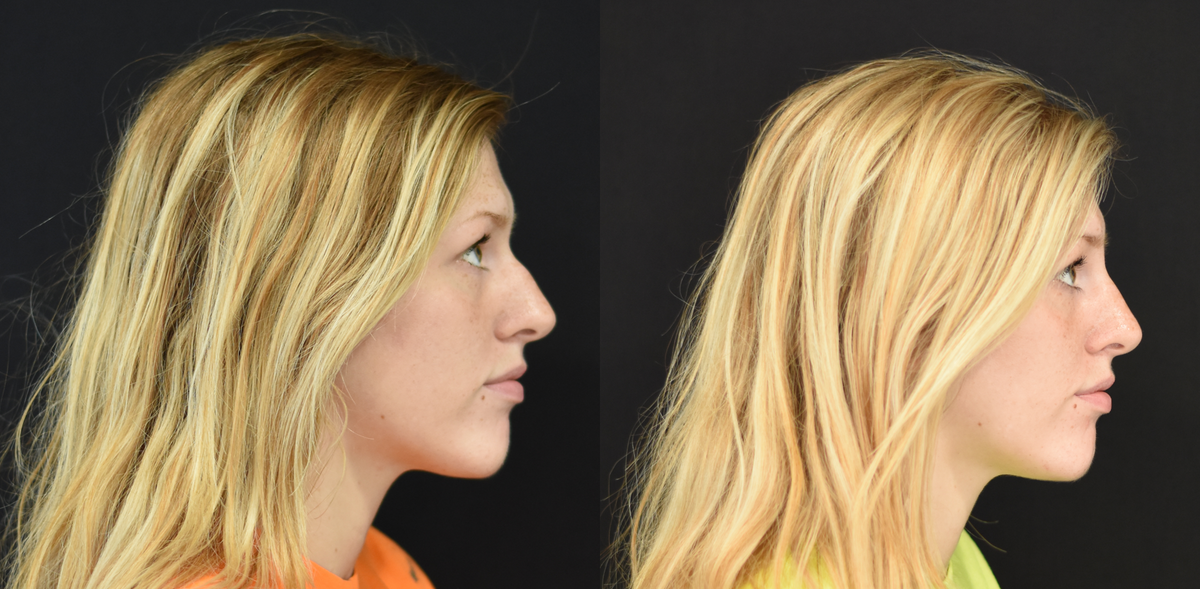Non-surgical Rhinoplasty

Dermal fillers such as Restylane® can be an excellent option to make modest changes to balance the nose and harmonize it with the face without surgery. Known as a non-surgical or liquid rhinoplasty, the procedure can increase symmetry, lift a drooping tip, camouflage a nasal hump, improve definition and projection, and smooth irregular contours on the nose. It demonstrates immediate results, can be long-lasting but reversible, and usually results in less swelling than a surgical rhinoplasty. But while a non-surgical rhinoplasty can be an effective option, a surgical rhinoplasty may be more appropriate for those who desire a more comprehensive, refined, and permanent treatment. Dr. Harmon is a fellowship trained facial plastic surgeon who specializes in both non-surgical and surgical rhinoplasty. He will work closely with each individual to formulate a personalized plan that reflects their needs while weighing the advantages and disadvantages of each approach.

This 24-year-old came to Dr. Harmon with a desire smooth the bump on her nasal bridge in a natural way and without surgery. Hyaluronic acid filler was added to the bridge of her nose above the bump in order to accomplish this.
Am I a good candidate?
Candidates often have concerns about the shape of the bridge or tip of their nose but are hesitant about surgical interventions to address these concerns. A non-surgical rhinoplasty can address these areas of concern.
Most candidates for non-surgical rhinoplasty range in age from 20s to 70s. A consultation is essential to determine candidacy for the procedure, because there may be factors that preclude this procedure for certain individuals. Reasonable expectations must be established about what a non-surgical rhinoplasty can and cannot accomplish as with all plastic surgery procedures.
Expected recovery
Recovery from a non-surgical rhinoplasty is generally minimal and always specific to the individual. The duration of recovery will vary from person to person. There are no incisions made with a non-surgical rhinoplasty.
Some swelling is expected after a non-surgical rhinoplasty. Post-treatment swelling is usually significantly improved or resolved within 2 to 7 days. Post-treatment bruising is generally minimal and is usually significantly improved or resolved within 5 to 7 days.
What to expect in a consultation
Expect a detailed, informative conversation with Dr. Harmon about your concerns and aesthetic goals regarding your nose. He will assess your anatomy and develop a personalized treatment plan to address your concerns and aesthetic goals.
Frequently Asked Questions
- Who performs all non-surgical rhinoplasty procedures at Harmon Facial Plastic Surgery?
- Dr. Jeffrey Harmon performs all non-surgical rhinoplasty procedures himself. Dr. Harmon has the detailed understanding of facial anatomy and the experience as a fellowship-trained facial plastic surgeon to provide the safest, most effective treatment.
- What type of anesthesia is required?
- Non-surgical rhinoplasty can generally be performed comfortably with topical anesthesia with or without injected local anesthesia.
- What product is used to perform a non-surgical rhinoplasty?
- Hyaluronic acid filler is used to perform a non-surgical rhinoplasty.
- Is a non-surgical rhinoplasty with hyaluronic acid filler a good alternative to rhinoplasty?
- There are limits to what can be accomplished with a non-surgical rhinoplasty. For example, a non-surgical rhinoplasty can be good for an individual who has a large hump on their nose that they would like softened. However, refinement of the nasal tip, narrowing of the bridge of the nose, and reducing the size of a large hump require a surgical rhinoplasty, either open or endonasal.
Why Choose Dr. Harmon
- The mission of Harmon Facial Plastic Surgery is to help people along their journey towards self-confidence, to feel good about feeling good.
- Dr. Harmon is a double board-certified facial plastic surgeon.
- Dr. Harmon values making patients feel welcomed, listened to, and respected.
- Dr. Harmon graduated with honors from Cornell University with a Bachelor of Science degree in molecular biology.
- Dr. Harmon earned his medical degree from the University of Cincinnati.
- Dr. Harmon underwent five years of extensive training in head at neck surgery at the prestigious residency program at the University of Cincinnati.
- Dr. Harmon then underwent focused fellowship training in cosmetic facial plastic surgery through the American Academy of Facial Plastic and Reconstructive Surgery (AAFPRS) with the world-renowned surgeon, Dr. Andrew Jacono, on Park Avenue in New York City.
- Dr. Harmon posts frequently and covers a wide range of topics, including procedure-specific information, volunteering, general health, and much more. Read more from Dr. Harmon by visiting his blog.
- Harmon Facial Plastic Surgery can be reached here.
Disclaimer: This page is for educational purposes only and does not constitute direct medical advice. Moreover, this page should not be used as a substitute for direct medical advice. It is essential that you have a consultation with a qualified medical provider prior to considering any treatment in order to determine whether you are a candidate for treatment. This will also allow you the opportunity to discuss any potential benefits, risks, and alternatives to the treatment. In addition, some treatments and statements have been evaluated by the Food and Drug Administration. Other treatments may be used off-label as defined by the Food and Drug Administration. Specific information on whether a treatment is considered off-label by the Food and Drug Administration can be obtained at Harmon Facial Plastic Surgery.
